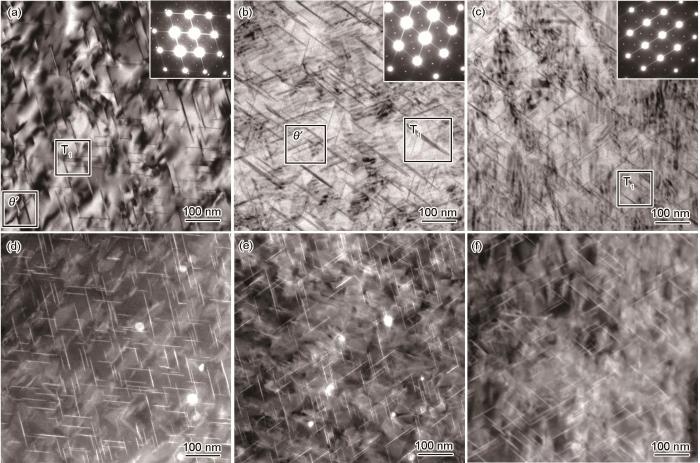与传统铝合金相比,新型铝锂合金有高弹性模量、高比强度和刚度、良好的耐蚀性、可回收再利用等优点,是21世纪航空航天工业最有应用价值的轻质高强结构材料[1]。具有晶体织构的铝锂合金,表现出优良的强韧性[2]。因此,轧制和拉伸等形变处理是提高铝锂合金整体力学性能的常用方法。但是,经过轧制和拉伸的铝锂合金比传统铝合金具有更明显的各向异性,严重限制了其在航空航天领域的应用。影响铝锂合金各向异性的因素很多,其机理也很复杂。El-Aty等[3]研究了Al-Li合金的变形行为、强化机理和各向异性,认为影响合金各向异性的主要因素包括晶体织构、纤维取向和主要析出相的特征。Zhao等[4]研究了沉淀相对2090铝锂合金各向异性的影响,指出T1相容易在亚晶界处析出。其原因是,晶界附近的位错密度较高,晶间分层倾向的增大削弱了晶粒间的变形传递,从而使晶体织构对屈服强度各向异性的影响降低。Cho等[5]研究了晶粒形状和织构对铝锂合金板材屈服强度各向异性的影响,发现沿长晶轴45°方向施加外应力使最大剪应力沿晶界方向发展,位错最容易向基体移动。这表明,最大剪应力方向与晶界方向一致时材料的屈服强度较低。因此,细长晶粒材料的屈服强度各向异性取决于织构和应变不相容性的方向差异,即晶粒形状。
2060-T8合金是第四代铝锂合金的典型代表,可通过进一步降低Li含量和提高Mg含量并添加多元微合金化元素和结合过时效工艺,使其具有较高综合性能特别是良好的耐损伤性能,用其替代传统的2X24合金可实现减重和延寿的效果。但是,经过扎制的铝锂合金具有明显的各向异性,本文研究了2060铝锂合金厚板组织和力学性能的各向异性并分析了相关规律。
1 实验方法
表1 2060 铝锂合金的实测成分
Table 1
| Element | Cu | Li | Mg | Ag | Mn | Zr | Zn | Al |
|---|---|---|---|---|---|---|---|---|
| Proportion | 3.75 | 1.15 | 0.75 | 0.3 | 0.25 | 0.12 | 0.32 | Bal |
图1
图1
取样示意图和标准拉伸试棒的尺寸
Fig.1
Sampling diagram and standard tensile test bar size diagram (unit: mm)
在Axiovert 40 型金相显微镜下观测金相组织。在Quanta 200型环境扫描电子显微镜(SEM)下观察断口形貌。从2060铝锂合金厚板上采用线切割工艺截取0.5 mm厚试样,先将其粗磨至120 μm,再用5000目砂纸打磨至70 μm左右,最后将样品冲成直径为3 mm的圆片,在MIP-1A型磁力驱动双喷减薄仪上进行双喷化学减薄、穿孔,然后在JEM-3010型高分辨透射电子显微镜下进行显微组织观察。电子衍射背散射(EBSD)在FEI Helios NanoLab G3 UC双束扫描电子显微镜下进行。
2 结果和分析
2.1 室温拉伸力学性能
表2 2060铝锂合金不同方向的室温拉伸性能
Table 2
| Sample No. | σb / MPa | σ0.2 / MPa | δ / % | Z/% |
|---|---|---|---|---|
| IPA /% | 4.3 | 9.0 | 22.4 | 36.2 |
| 0° | 626.3 | 605.3 | 8.8 | 16.4 |
| 45° | 580 | 528.7 | 9.6 | 22.9 |
| 90° | 618.7 | 573.3 | 6.1 | 12.8 |
式中Xmax,Xmin,Xmid分别为力学性能指标(σb,σ0.2,δ,Z)各自对应的3个方向上的数值中的最大值、最小值及中间值。从表2可见,0°方向的屈服强度和抗拉强度最高,分别为626.3 MPa和605.3 MPa。45°方向的屈服强度最低,为580 MPa,但是其延伸率和断面收缩率最高,分别为9.6%和22.9%。90°方向的延伸率和断面收缩率最低,分别为6.1%和12.8%。这表明,2060铝锂合金厚板具有明显的各向异性。抗拉强度的IPA值较小,屈服强度、延伸率和断面收缩率的IPA值都比较大,表明此时的合金板材具有明显的平面各向异性,塑性各向异性高于强度各向异性,并且屈服强度的各向异性比抗拉强度更为明显。
2.2 微观组织
图2
图2
2060合金不同方向的金相组织
Fig.2
Metallographic structure of 2060 alloy in different directions (a) 0°, (b) 45°, (c) 90°
图3
图3
2060铝锂合金不同方向的TEM显微组织及扫透照片
Fig.3
TEM microstructure and scanning pictures of 2060 Al-Li alloy in different directions (a) 0°, (b) 45°, (c) 90°, (d) 0°-STEM, (e) 45°-STEM and (f) 90°-STEM
2.3 不同方向晶粒的形态和织构
图4
图4
厚板不同方向的(001)、(111)、(110)极图
Fig.4
(001), (111) and (110) pole diagrams of thick plate in different directions (a) 0°, (b) 45°, (c) 90°
3 分析和讨论
2060铝锂合金厚板的显微组织主要是拉长的扁平状晶粒和不同程度的再结晶晶粒,在轧制过程中轧制力的作用使原先等轴的晶粒沿着主变形方向显著拉长。在后续热处理过程中部分变形晶粒发生再结晶,重新形核长大为等轴晶粒。从图2可见,2060铝锂合金的内部组织大部分是显著拉长的扁平状晶粒,在晶界附近可见部分等轴的再结晶晶粒。KV Jata[7]和范春平[15]等的研究表明,组织拉长为流线型会加剧材料的各向异性。拉长的晶粒使不同方向上的晶界密度不同,而晶界对材料的性能有较大的影响。晶界处的原子排列不规则,结晶时晶界上聚集了许多不固溶的杂质,在塑性变形过程中晶界阻碍位错运动而使晶界处堆积大量位错。这些位错使晶界内的晶格畸变,从而使材料强化。晶界密度不同,强化效果也不同[14]。0°方向的晶界密度明显比45°方向和90°方向的高,位错穿过的晶粒数更多因此容易在晶界处塞积,使材料的强度更高。但是,位错的塞积不能松弛由位错引起的应力集中,使材料在外力作用下较易发生断裂而导致0°方向的塑性较差[16]。
式中K1为常数;G为剪切模量;f为颗粒体积分数;r为颗粒半径;b为伯氏矢量;r0为位错芯半径。从图3可以看出,0°方向T1相的数量稍微多于其他方向,且分布均匀,0°方向非常密集的晶界大大阻碍了位错的运动。位错在晶界处的塞积使其抗拉强度和屈服强度都明显高于其他方向。45°方向的T1相数量与0°方向差别不大,可见大部分条状的T1相粗化为板片状,而且在晶内分布杂乱,其强化效果最弱,强度最低。但是,由于晶粒较为粗大,位错运动到晶界处所需路程较长,使晶界处的位错塞积减弱,可开动滑移系较多,使得45°方向的塑性最好[16]。90°方向T1相的数量较少,但是T1相仍为板条状,尺寸比45°方向小很多,其强化效果也比45°方向好。
4 结论
(1) 2060铝锂合金厚板力学性能各向异性的规律为:0°方向强度最高(626.3 MPa),延伸率和断面收缩率较低;45°方向强度最低(580 MPa),但是延伸率和断面收缩率最高(9.6%和22.9%);90°方向强度稍低于0°方向,延伸率和断面收缩率最低(6.1%和12.8%)。
(2) 0°、45°和90°方向合金的主要析出相为T1相,在0°和45°方向还有θ'相和少量的球形δ'相。0°方向析出相数量最多且分布均匀,45°方向析出相的尺寸较大,大部分的T1相粗化为板片状,90°方向析出相的数量相对较少,但是T1相的尺寸明显比45°方向更小。
(3) 2060铝锂合金厚板45°方向的织构强度最高,出现了较强的再结晶织构P{011}<122>,还有较弱的形变织构Goss织构{011}<100>;0°方向织构的强度仍然较高,以再结晶P{011}<122>为主,还有较弱的形变织构Copper{112}<111>;90°方向的织构强度较弱,以形变织构Copper{112}<111>和形变织构S{123}<634>为主。
参考文献
Research progress of Al-Li alloy
[J].
铝锂合金研究进展
[J].
Modeling the evolution of anisotropy in Al-Li alloys: application to Al-Li 2090-T8E41
[J].
Strengthening mechanisms, deformation behavior, and anisotropic mechanical properties of Al-Li alloys: A review
[J].
The effect of precipitates on anisotropy of Al-Li alloys 2090 and 2090+Ce
[J].
Effects of grain shape and texture on the yield strength anisotropy of Al-Li alloy sheet
[J].
Effect of trace Ag on microstructure and mechanical properties of ZL114A aluminum alloy
[J].
微量Ag对ZL114A铝合金组织和力学性能的影响
[J].
The anisotropy and texture of Al-Li alloys
[J].
Effect of pulsed current on dynamic recrystallization kinetics of 2091 Al-Li alloy
[J].
脉冲电流对2091铝锂合金动态再结晶动力学的影响
[J].
Coarsening of δ'(Al3Li) precipitates in binary Al-Li alloys
[J].
Effect of aging treatment on microstructure and properties of rapidly solidified Al-Li-Cu and Al-Li-Cu-Zr alloys
[J].
时效处理对快速凝固Al-Li-Cu及Al-Li-Cu-Zr合金结构与性能的影响
[J].
Microstructure evolution and mechanical properties of 2A66 Al-Li alloy by reciprocating upsetting and extrusion
[D].
往复镦2A66铝锂合金的组织演变及力学性能研究
[D].
On the influences of Li on the microstructure and properties of hypoeutectic Al-7Si alloy
[J].
Anisotropy of 2195 Al-Li alloy
[J].
2195 铝锂合金各向异性研究
[J].
Study on anisotropy of 2A66 aluminum-lithium alloy sheet
[J].
2A66 铝锂合金板材各向异性研究
[J].
Microstructure, tensile properties and fracture toughness of 2397 Al-Li alloy
[J].
2397 铝锂合金显微组织、拉伸性能和断裂韧性研究
[J].
Study on anisotropy and fatigue properties of 2297-T87 Al-Li alloy thick plate
[D].
2297-T87铝锂合金厚板各向异性和疲劳性能研究
[D].
Microstructure and fatigue damage behavior of 2060 Al-Li alloy sheet
[J].
2060铝锂合金薄板组织特征及疲劳损伤行为
[J].
Co-strengthening contribution of δ' and T1 phases of Al-Li alloy 2090
[J].
2090 铝锂合金中δ'相和T1相的复合强化作用
[J].
Grain size, misorientation, and texture evolution of copper processed by equal channel angular extrusion and the validity of the Hall-Petch relationship
[J].








